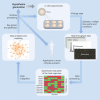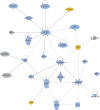Systems biology and the host response to viral infection
- PMID: 18066032
- PMCID: PMC7097743
- DOI: 10.1038/nbt1207-1383
Systems biology and the host response to viral infection
Abstract
Will our increasing understanding of virus-host interactions translate into a new generation of antiviral therapeutics or steer us toward an expensive journey to nowhere?
Figures



References
-
- Noble D. The Music of Life: Biology Beyond the Genome. 2006.
-
- Wheeler J, McHale M, Jackson V, Penny M. Assessing theoretical risk and benefit suggested by genetic association studies of CCR5: experience in a drug development programme for maraviroc. Antivir. Ther. 2007;12:233–245. - PubMed
Publication types
MeSH terms
LinkOut - more resources
Full Text Sources
Other Literature Sources
Medical

